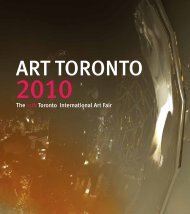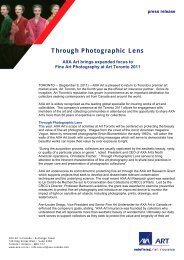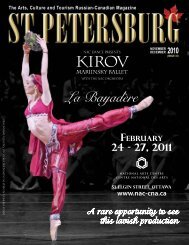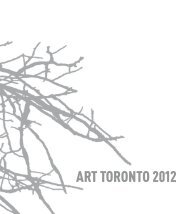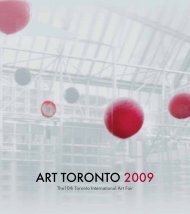fixed - Art Toronto
fixed - Art Toronto
fixed - Art Toronto
You also want an ePaper? Increase the reach of your titles
YUMPU automatically turns print PDFs into web optimized ePapers that Google loves.
The Bata Shoe Museum<br />
327 Bloor Street West (at St. George Street), <strong>Toronto</strong> ON M5S 1W7, Canada<br />
Tel: 416 979 7799 Web: www.batashoemuseum.ca<br />
Textile Museum of Canada<br />
55 Centre Avenue, <strong>Toronto</strong> ON M5G 2H5, Canada<br />
Tel: 416 599 5321 Fax: 416 599 2911 Email: info@textilemuseum.ca Web: www.textilemuseum.ca<br />
The Textile Museum of Canada is one of <strong>Toronto</strong>’s most engaging visual arts organizations. With<br />
more than 12,000 objects from more than 200 countries and regions, the TMC’s permanent<br />
collection celebrates cultural diversity and includes traditional fabrics, garments, carpets<br />
and related artifacts such as beadwork and basketry. The Museum offers a broad variety of<br />
exhibitions including themed shows based on our permanent collection and contemporary<br />
exhibitions of the work of Canadian and international artists. Visit fibrespace, our permanent<br />
hands-on gallery where guests are introduced, in both physical and tactile ways, to the many<br />
ways textiles influence their lives. Touch and explore the properties of cloth and see the endless<br />
possibilities of pattern and decoration. In fibrespace visitors will - discover fibre, discover colour,<br />
discover textiles and discover meaning. Open seven days a week, the TMC is in the heart of<br />
downtown <strong>Toronto</strong> steps from the St. Patrick subway station and several blocks from the Eaton<br />
Centre, <strong>Toronto</strong> City Hall, and the <strong>Art</strong> Gallery of Ontario.<br />
LEFT: from the ‘Beauty, Identity, Pride’<br />
exhibition.<br />
Sioux, c.1880-90<br />
In addition to fine beadwork,<br />
nineteenth century Sioux women also<br />
produced exceptional quillwork. Shoes<br />
and leggings decorated with elaborate<br />
quillwork in strong geometric designs<br />
were worn by both Sioux men and<br />
women. Quills could be dyed any<br />
number of vibrant colours, but the<br />
Sioux tended to favour bright red and<br />
yellow for their footwear.<br />
© Bata Shoe Museum, <strong>Toronto</strong>.<br />
Photo: Hal Roth<br />
RIGHT: on display in ‘The Charm of<br />
Rococo’<br />
English, c.1780-85<br />
By the 1760s, attention was often<br />
called to the heel by the use of<br />
contrasting silk. Soaringly high heels<br />
often resulted in weakness under<br />
the instep; to compensate, many<br />
shoemakers employed a wedge-like<br />
structure.<br />
© Bata Shoe Museum, <strong>Toronto</strong>.<br />
Photo: Hal Roth<br />
HOURS<br />
Monday to Saturday: 10am - 5pm<br />
Thursday: 10am - 8pm<br />
Sunday: 12pm - 5pm<br />
Allow 1.5 to 2 hours to visit<br />
Wheelchair accessible<br />
The Bata Shoe Museum is the life project of a determined individual with a passionate eye for<br />
footwear who has been scouring the globe for unusual shoes for decades. The objects in the<br />
Museum span thousands of years and many walks of life. Relating to birth, childhood, marriage,<br />
religion, societies and styles of the past and present, the diverse collection of footwear, found<br />
nowhere else in the world, promises to enhance your understanding of human cultures and<br />
captivate your imagination.<br />
Beauty, Identity, Pride: North American Footwear from the Bata Shoe Museum<br />
Opening to the public on October 24, this new exhibition displays exquisite examples of<br />
footwear created by North America’s indigenous peoples. Visitors will see up close techniques<br />
and artistry in sophisticated beading and quillwork, the use of decorative metals, different hides,<br />
ribbons and other materials, all of which exemplify the outstanding quality and detail of Native<br />
footwear.<br />
Chronicles of Riches: Treasures from the Bata Shoe Museum<br />
Imagine yourself stepping ‘behind the scenes’ in the Museum’s vast private storage area and<br />
taking a peek at jewelled golden mojari, extravagant chopines, and even Napoleon’s socks worn<br />
when he languished in exile.<br />
The Charm of Rococo: Femininity and Footwear in the 18th Century<br />
Emanating from the French court, the Rococo aesthetic infused a sensuous charm and delicate<br />
grace into 18th century fashion. In the opulent age of Louis XV, one’s shoes no less than one’s<br />
wit had to sparkle.<br />
All About Shoes: Footwear Through the Ages<br />
A fascinating look at the many facets of footwear: its evolution and symbolism through the<br />
ages, the methods and materials of its manufacture, and its place in our lives and imaginations.<br />
HOURS<br />
Open daily 11am – 5pm,<br />
Wednesdays 11am – 8pm<br />
Wednesday 5pm – 8pm is Pay-<br />
What-You-Can admission<br />
Exhibition sponsor:<br />
Primavera Furnishings<br />
Media sponsor:<br />
Classical 96.3 fm<br />
Generously supported by:<br />
The Anne Angus Contemporary<br />
Program Fund<br />
Imperial Tobacco Canada Foundation<br />
The Blues<br />
To March 2, 2008<br />
Curated by Patricia Bentley. Reflecting on the symbolism of colour, the globalizing effects<br />
of denim and the haunting sounds of blues music, The Blues tells both the ancient and<br />
contemporary story of blue.<br />
In The Blues, 36 textiles in our permanent collection from West Africa, East Asia and Canada,<br />
along with Canadian denim jeans and Japanese pieces lent from private collections, join works<br />
by six contemporary artists whose working methodologies are embedded in concepts of blue:<br />
Mary Lee Bendolph (Gee’s Bend), Dorothy Caldwell, Judith Fielder, Léola Le Blanc, Chunghie Lee<br />
and Anna Torma.<br />
The Blues examines the powerful symbolism of a colour and a dye that has been viewed with<br />
suspicion and called “the devil’s dye”. Yet blue is also considered emblematic of wealth and<br />
power, as in West Africa; protective against poisonous insects and snakes, as in Japan; and even<br />
effective medicinally, as in many parts of Africa and East Asia. The mystique of the colour blue,<br />
beautiful, elusive, reflecting the sky and the sea, pervades human life and cultures around the<br />
world. In The Blues, you are invited to sample the many shades and tastes of blue.<br />
Indigo is an age-old and up-to-the-minute colouring agent for textiles – familiar to people<br />
around the world in the many shades of ubiquitous denim blue jeans. Originally a uniform for<br />
gold-miners, denim became a symbol of youthful protest in the 20th century and now marks the<br />
trend towards globalization in the 21st. The Blues follows the transition of this wardrobe staple<br />
from its inception to present day where the demand for blue jeans is more than one billion pairs<br />
– annually.<br />
Just as blue denim has become a worldwide uniform, crossing social and cultural boundaries,<br />
“the blues” colours an emotional mood and haunts the airwaves as the originator of popular<br />
western music. Author Richard Wright called blues music the sensualization of suffering. He<br />
captured a key theme of this exhibition. The blues in music form and the blues in textile form<br />
are modes of communication understood through the senses.<br />
44 Museums and Cultural Institutions of Ontario Museums and Cultural Institutions of Ontario 45




